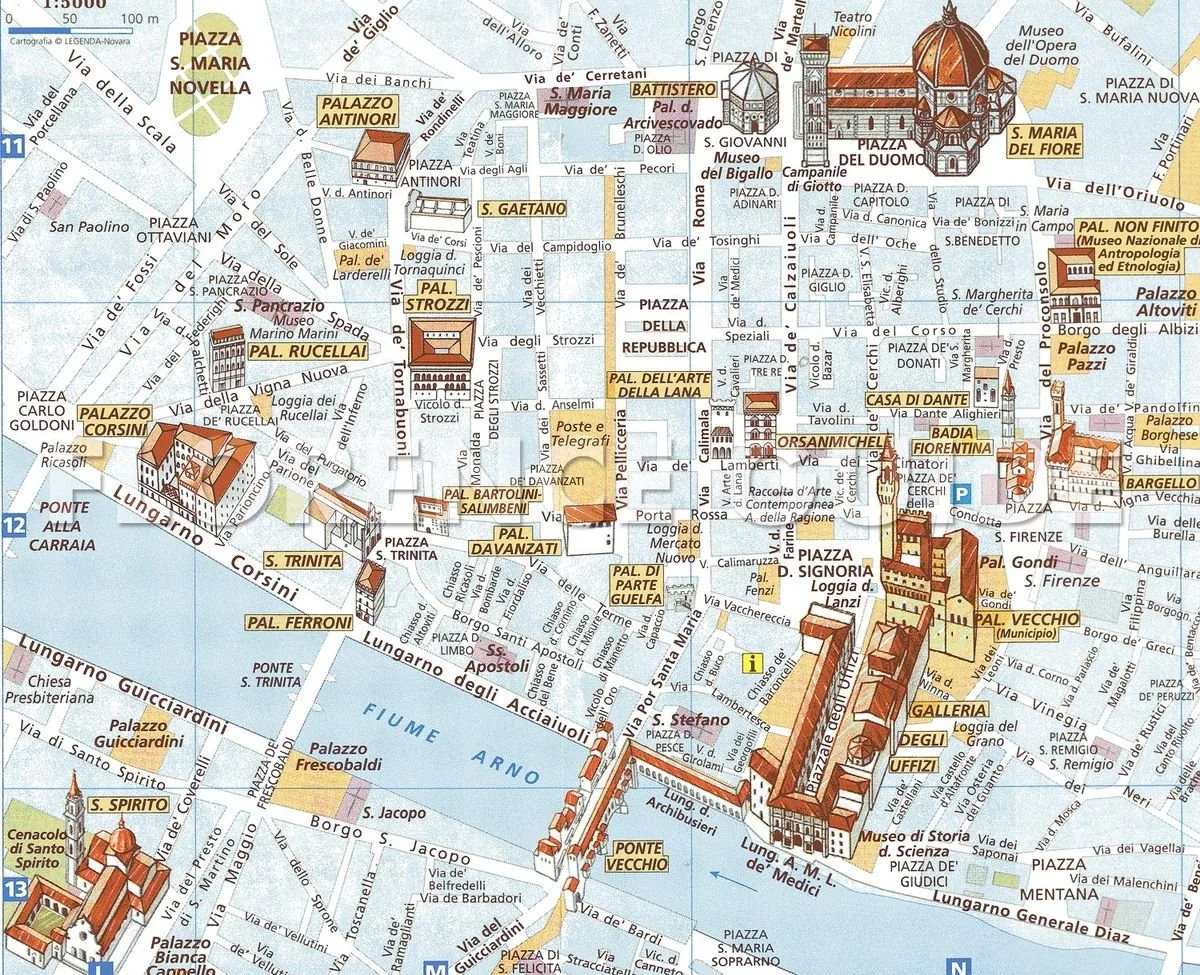Medieval Florence Map
Exploring the Origins of Renaissance Florence
Walking through Florence today, it’s easy to forget that beneath the elegant palaces and refined art galleries lies a medieval city. A medieval Florence map reveals the dense network of Florence's narrow streets, defensive towers, and small churches that shaped what would later become Renaissance Florence.
Before the grandeur of Brunelleschi’s dome and the humanist ideals of the Medici, the city was a fortress of merchants and guilds. Families like the Albizzi, Strozzi, and early Medici built tall buildings to assert power, while churches like Santa Croce and Badia served as both spiritual and social centers.
Downloading Old Maps of Florence
For those interested in exploring historical maps of Florence in greater detail, a valuable resource is available on Wikimedia Commons. You can download a variety of old maps of Florence, showcasing the city's layout across different periods. These maps provide insightful glimpses into Florence’s medieval and Renaissance past, highlighting streets, buildings, and landmarks as they appeared centuries ago. Visit the collection at Old maps of Florence on Wikimedia Commons to access high-quality images that can enrich your understanding and appreciation of this remarkable city’s history.
From Medieval Walls to Renaissance Vision
One of the best ways to explore Florence is to trace how the medieval map evolved into the elegant Renaissance layout. In the 14th century, the city was still enclosed by its walls, and Ponte Vecchio was the only bridge connecting the two sides of the Arno River. Around it, small shops sold gold, food, and wool — a tradition that remains alive today.
The arrival of Cosimo de Medici in the early 15th century marked a turning point. Under his influence, the city transitioned from medieval density to Renaissance harmony, funding artists and architects who would redesign Florence forever. Palaces replaced fortresses, and new maps began to reflect a city open to beauty and proportion.
Daily Life and Challenges in Medieval Florence
Life in medieval Florence was a vibrant tapestry woven with both opportunity and adversity. As the city grew into a hub of commerce and culture, its narrow streets bustled with activity. Merchants and artisans crowded the alleys, their shops spilling out onto the stone-paved lanes, especially near the iconic Ponte Vecchio. This historic bridge, lined with goldsmiths and traders, was the beating heart of Florence’s commercial life, while the nearby Santa Croce church offered a spiritual refuge and a gathering place for the community.
Florence’s city maps from this era reveal a dense network of winding streets, fortified towers, and grand palaces—many commissioned by the powerful Medici family. Cosimo de Medici and his predecessors, like Giovanni de Medici, left an indelible mark on the city, funding the construction of magnificent buildings and supporting the arts. The Medici’s influence is still visible today in the city’s palaces, churches, and the imposing cathedral of Santa Maria del Fiore, whose foundations were laid in medieval times.
Yet, daily life was not without its challenges. The city’s strategic position made it a target for rival powers, especially Milan, leading to frequent threats of war and the need for robust defenses. Towers like the Torre della Castagna and Torre dei Baldovinetti rose above the rooftops, symbols of both wealth and the ever-present need for security. Despite these dangers, Florence thrived, its streets alive with the sounds of commerce, music, and the chatter of citizens.
Florence’s churches, including the Badia and the cathedral, were more than places of worship—they were centers of learning, artistic innovation, and community life. Inside, frescoes and paintings told stories of faith and history, while outside, the city’s palaces and towers stood as testaments to the ambition and vision of its people.
Exploring Florence today, visitors can walk the same streets and visit the same places that shaped the city’s destiny. The left bank of the Arno, with its charming shops and medieval buildings, offers a close look at the daily rhythms of the past. Maps and images guide modern explorers through Florence’s rich history, connecting them to a time when every street corner held a story and every building echoed with the footsteps of merchants, artists, and Medici princes. In Florence, the past is never far away—each visit is a journey through time, inviting you to discover the enduring spirit of this remarkable Italian city.
Key Places to See Today
Key Places to See Today in FLorence
When walking through Florence with a medieval map in mind, look for traces of that earlier time:
Badia Fiorentina, one of the oldest churches, still surrounded by narrow alleys.
Santa Croce, a Gothic masterpiece that predates the Renaissance.
The Cathedral of Santa Maria del Fiore, built over a medieval foundation and crowned by Brunelleschi’s dome.
Ponte Vecchio, whose medieval shops have survived centuries of change.
These sites stand as living witnesses of Florence’s transformation from a medieval town to the capital of Renaissance Italy.
Reading the City Through Maps and Images
Historic maps and images of Florence help visualize this evolution. Comparing a medieval Florence map with modern cartography reveals how little the streets have changed — the heart of the city remains almost the same. The towers, palaces, and churches are not just relics but a continuous thread connecting Giovanni and Cosimo de Medici’s Florence with our own time.
A Timeless Journey
Whether you arrive from Milan or elsewhere in Italy, visiting Florence is a journey back in time. Each street tells a story, each building carries memory, and each place invites you to stand close to the roots of Western art and thought. With a medieval Florence map in hand, the city reveals not just where to go — but how history itself was built, street by street.
¿Quieres que ahora cree una imagen ilustrativa del mapa medieval de Florencia para acompañar el artículo?


